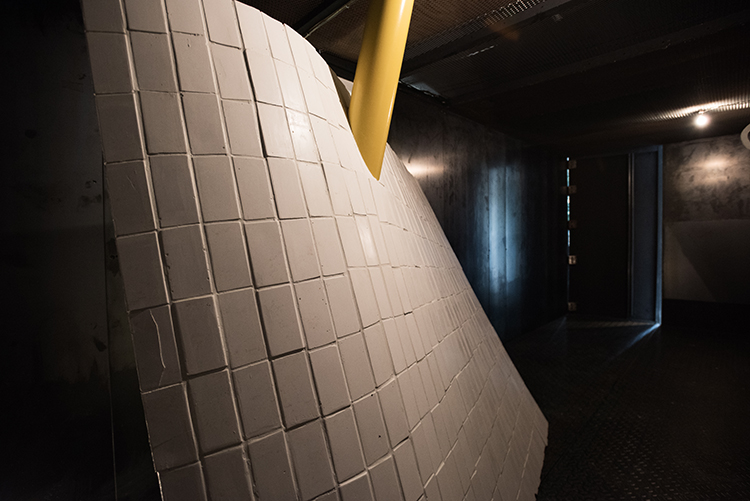In dwam
Risa Tsunegi
13 April – 29 June 2015
Opening night reception: 13 April, 19:30 – 21:30
 Wall Dance, Risa Tsunegi, 2015. Mixed media, approx 170 x 120 x 17 cm.
Wall Dance, Risa Tsunegi, 2015. Mixed media, approx 170 x 120 x 17 cm.
.
| 常木理早の作品は、60年代と70年代のアメリカのミニマリスト運動から大きく影響されています。 それに加え、ポスト抽象表現主義のエスセティックの影響も窺うことができます。 数多くのポスト抽象表現主義のアーティストのように、彼女の造る作品は一般的な姿を拒み、形のフィジオロジーに焦点を置きます。 彼女の作品に見る、形、重さ、重力、建物の空間を分割するような作品のあり方は、一見、アメリカ人彫刻家リッチャード・セラの作品を思い起こさせます。 しかし、彼とは違い、常木は驚きと欺瞞をテーマとします。 目で見える物が真実とは限りません。常木は、幻想を作り出す魔術師のようです。2009年の作品<ガーダー>の、重力に逆らうように空中に浮かぶ500センチの鋼のビームは、まさに魔術のようです。 この重たい鋼の柱は、あたかも動画の静止画のように時間が止まっているように見えます。常木がどうやってこの柱を時空に浮かばせたのかは、いくら見ても、分かりえないでしょう。 鋼に見える柱が実はフォームでつくられていて、コンクリートの地面に直面する角が実は地中に続く柱のサポートになっているのが、ツネギの魔法の秘密です。
同じく構造されているのが、彼女の2010年の作品<ドリップス>です。 鋼のフレームから垂れ下がるペンキの雫が、落ちる前の一瞬を永遠に止 め、保った作品です。また、この作品も<ガーダー>のように、ペンキはスポンジを使ってつくった作品です。 視聴者を惑わしていないのであれば、常木の作品は視聴者に空間の構造を尋ねています。 視聴者に新しい空間の見方を主張しているかのようです。 今回のザ・コンテインナーで展示する作品<In dwam>では、コンテナのサイズと空間を利用し、新しい空間とイルージョンをつくりま す。 インスタレーションは、<ウォール・ダンス>というミックスド・ メディアでつくられた壁と柱の構造と<アタッチメント>という天井からぶら下がる小さな彫刻の二つの作品です。 <ウォール・ダンス>(170x120x177cm)は、タイル張りの壁の中心にコンテナの天井から地面へ柱が突き刺さっている作品です。 一見すると、この作品は後ろの壁へと繋がるようであり、石膏で造られているように見えます。 しかし、よく見てみると分かるのが、壁が実は奥に向かっていくにつれカーブし、ハンドメイドの石膏製タイルで覆われた、フォームで形成された土台だということが分かります。 一見頑丈な構造も、映画の撮影現場のようにフェイクな模造でしかない幻想ということが明らかになります。 <アタッチメント>(25x5x120cm)は、天井からさがるコードの立体作品です。これは、コンテナという展示スペースの建築構造を主張するための作品です。
常木理早は、群馬出身のアーティストで、ロンドンのChelsea College of Art and Designでファイン・アートの学士を取得してから、 Glasgow School of Artで修士を取得しました。 彼女は、Glasgow Sculpture StudioでのMFA修士フェローシップの受賞者であり、スコットランドのアート・カウンセルなどからグラントも受け取っています。
|
Risa Tsunegi’s work draws inspiration from the American Minimalist movement of the Sixties and Seventies and makes direct references to Post-abstract Expressionist aesthetics. Similarly to many Abstract Expressionist and Post-abstract Expressionist artists, her pieces display a rejection of the figure and focus on the physiology of shapes and forms. Her preoccupation with form, weight, and gravity and the sculpture’s experience as a mean to section architectural spaces somewhat recall of the works of the American sculptor Richard Serra. In contrast to Serra, though, much of Tsunegi’s work centralizes on surprise and deception. What you see is never what you get.Tsunegi is a master illusion maker.Her sculptural work Girder (2009), for example, showcasing some 500 cm long girder (steel construction beam) in a gravity defying composition, seems impossible – standing on a single edge, stretched upwards towards the ceiling with no support, tilted in space; it evokes the works of a magician. The heavy steel beam seems to be frozen in action, like a still from a movie documenting its fall. There is no visual clue how Tsunegi managed to suspend it in time and space. Not even a close inspection can reveal the entire sculpture is made of foam, meticulously shaped and finished to resemble steel, where the only edge that makes contact with the cement floor extends underground to support the awkward installation.
Similarly fashioned is her piece Drips (2010), steel structure with paint drips. The pink paint drips dangle from the metal frame as if dried just before they dropped to the ground. Again, only scrupulous observation would reveal that what appears to be paint at first look is painstakingly sculpted sponge, fixed to the metal structure. Looking at Tsunegi’s work always inspires awe. When she’s not deceiving the viewer she cleverly divides spaces, often forcing the viewer to examine the surroundings in a specific predetermined method. It’s as if she takes pleasure in making the spectator experience the space the way she pre-resolved – performing for her, compelling the viewer to reconsider the architecture of the environs, paying attention to the structural details of the space. In dwam, Tsunegi’s exhibition at The Container, is a site-specific installation, a deliberation of the shape and size of the actual container that expertly combines both her interests as a sculptor – the renegotiation of spaces and the creation of illusions. The installation consists of two pieces Wall dance (2015), a large mixed media wall-like structure intervened by a column and Attachment (2015), a small sculpture suspended from the ceiling. Wall Dance (approx 170 x 120 x 17 cm) is a constructed tiled wall with a column piercing through its centre that extends from the ceiling of The Container. At first view the sculpture seems to stretch to the back wall of the space and appears to be made from plaster. Closer inspection reveals the wall curves towards the back and invites the viewers to walk around it to reveal a foam construction that is covered with hand-made plaster tiles. It beautifully sections the space and the back of the structure, with its unfinished quality, stands in contrast to the carefully formed front view. What appears to be a solid and heavy construction reveals itself to be a light and fake structure – like a movie set assembled to create an allusion. Attachment (approx 25 x 5 x 120 cm) is a cast-like formation of cords extending from the ceiling to echo the pipes that are fixed on the cement wall that make up the permanent structure of The Container. This smaller piece is creating a dialogue with the larger sculptural work and reinforces the architecture of the exhibition space.
Risa Tsunegi is a Japanese artist, born and raised in Gunma. She has received her Bachelor’s of Fine Arts from the Chelsea College of Art and Design in London, England and her Master of Fine Art from the Glasgow School of Art in Scotland. She is the recipient of the Glasgow Sculpture Studios MFA Graduate Fellowship supported by the Gordon Foundation and the Hope Scott Trust (2009), as well as awarded Creative and Professional Development Grant, Scottish Art Council (Arts Trust Scotland, 2010) and a grant from Creative Scotland in 2011. She currently resides in Tokyo.
|